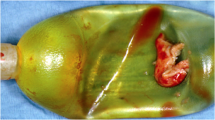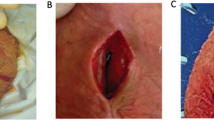Abstract
Erectile dysfunction afflicts millions of men. A group of patients with advanced degeneration of their erectile tissue do not respond to pharmacological therapy, and surgical prosthetic reconstruction represents an attractive and highly satisfying alternative. Yet many men are unwilling to take this step due to fear of infection. Implanted prosthetic devices are at risk for infection because they provide a platform for the development of a bacterial biofilm, an organized bacterial colony that grows on the surface of the implanted material. The biofilm is resistant to all efforts to eradicate it short of removal of the foreign material. Bacteria may attach to the surface of the foreign material by surface charge attraction, hydrophilic/hydrophobic interactions, and by specific attachment by fimbrae. Growth, colonization, and maturation follow bacterial attachment. A mature biofilm is composed of three layers: a linking film binding the biofilm to the surface; a base film made up of a compact layer of bacteria; and a surface film from which free-floating bacteria can arise and spread. The majority of the surface layer is made up of exopolysaccharide matrix. Bacteria deep within the biofilm matrix live in a protected environment; diffusion of antibiotics is difficult, low oxygen tension leads to a lower bacterial metabolic rate rendering the bacteria functionally resistant to high levels of antibiotics. Effective strategies to reduce prosthetic infection levels must rely on the prevention of biofilm formation through surface modification. Possible mechanisms include the addition of antimicrobials to the surface of the device, or chemical modifications, which reduces bacterial attachment.
This is a preview of subscription content, access via your institution
Access options
Subscribe to this journal
Receive 8 print issues and online access
$259.00 per year
only $32.38 per issue
Buy this article
- Purchase on Springer Link
- Instant access to full article PDF
Prices may be subject to local taxes which are calculated during checkout
Similar content being viewed by others
Author information
Authors and Affiliations
Rights and permissions
About this article
Cite this article
Silverstein, A., Donatucci, C. Bacterial Biofilms and implantable prosthetic devices. Int J Impot Res 15 (Suppl 5), S150–S154 (2003). https://doi.org/10.1038/sj.ijir.3901093
Published:
Issue Date:
DOI: https://doi.org/10.1038/sj.ijir.3901093
Keywords
This article is cited by
-
Manganese dioxide coating reduces bacterial adhesion and infection in silicon implants in animal model
World Journal of Urology (2020)
-
Functions of a hemolysin-like protein in the cyanobacterium Synechocystis sp. PCC 6803
Archives of Microbiology (2011)
-
Penile prosthesis coating and the reduction of postoperative infection
Current Urology Reports (2004)



